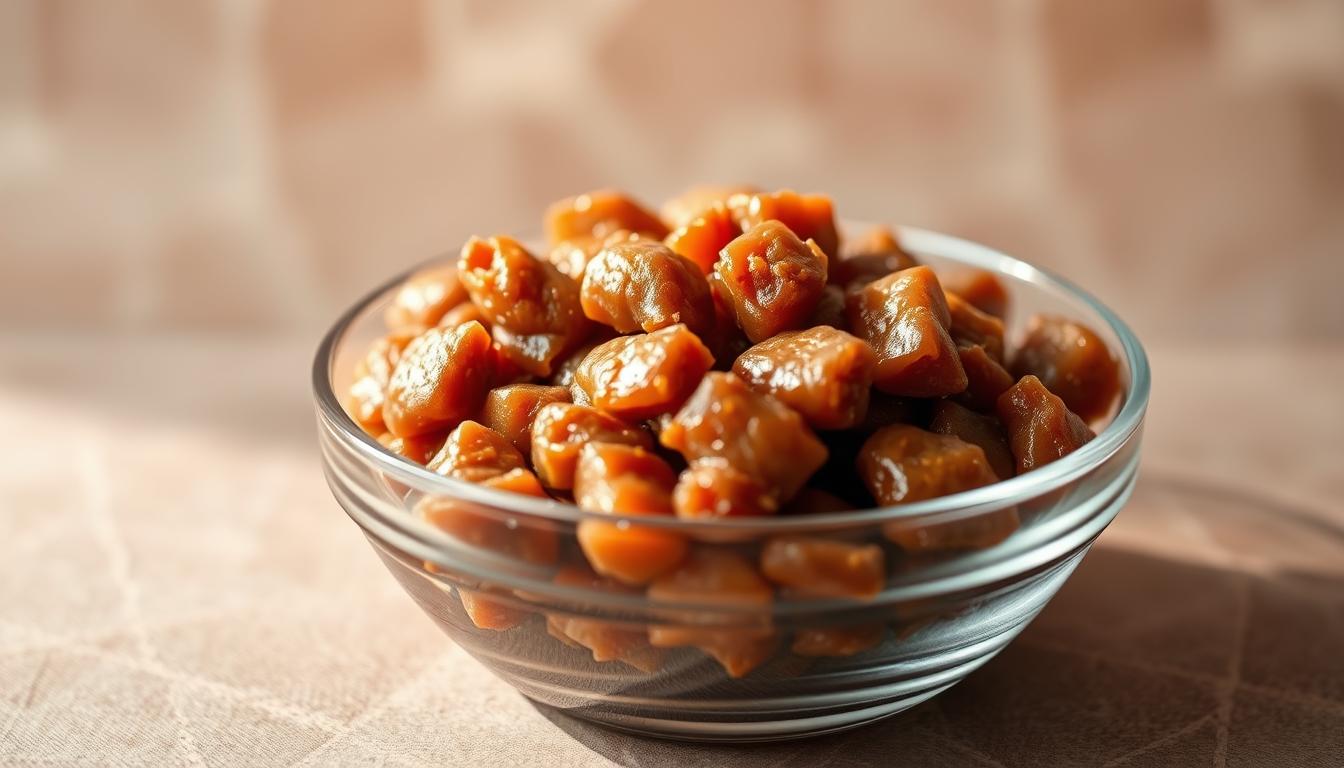As a cat owner, you want the best for your feline friend. Low carb canned cat food is a great choice. It’s perfect for cats with diabetes or weight issues. This type of food has high protein and low carbs, helping manage these conditions.
Look for canned cat food with a balance of high protein, moderate fat, and low carbs. This balance is key. Some top picks include Tuft + Paw Really Great Cat Food and Tiki Cat After Dark Chicken & Quail. These foods are tasty and packed with nutrients for your cat’s health.
Key Takeaways
- Low carb canned cat food is beneficial for cats with diabetes or weight issues.
- High protein and low carbohydrate content can help manage these conditions.
- Look for low carb canned cat food with a macronutrient balance of high protein, moderate fat, and low carbohydrates.
- Low carb cat food should contain at most 15% carbohydrates on a dry matter basis.
- Wet cat food provides hydration, which is vital for cats, including those with health issues.
- Low carb canned cat food can aid in hydration, which is important for cats with diabetes or kidney issues.
Understanding Low Carb Canned Cat Food
Feeding your cat the right food is key. Low carb canned cat food is great for diabetic cats. It helps manage their diabetes and keeps them healthy. Let’s look at what makes low carb canned cat food a good choice for your pet.
Cats need a diet full of animal protein and fat. But many cat foods have too many carbs. Low carb canned cat food gives your cat a more natural diet.
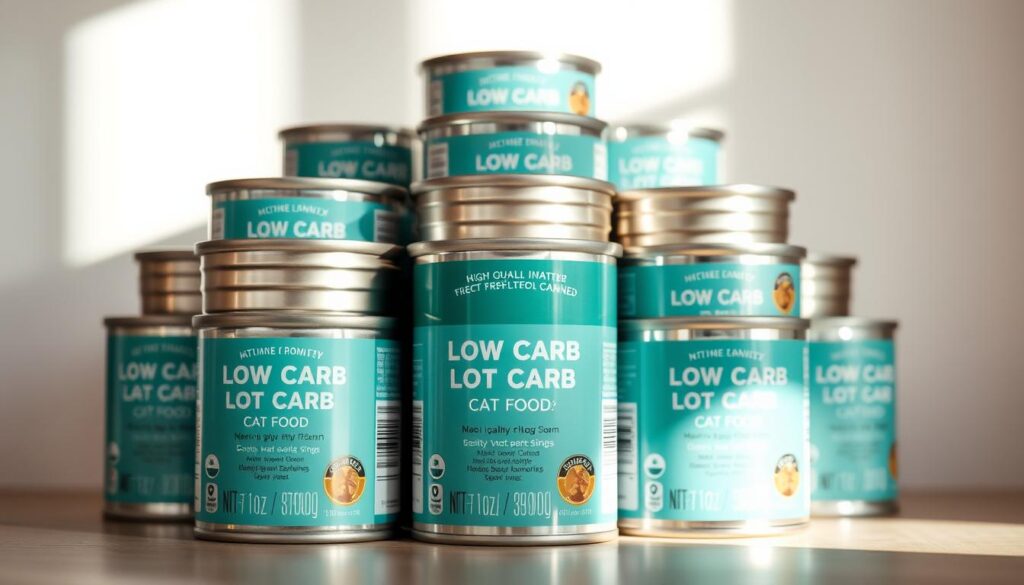
Low carb canned cat food has lots of protein and fat, but little carbs. A good canned cat food should get 40% of its calories from protein. It should get no more than 10% of its calories from carbs. Choosing the right low carb canned cat food helps your cat stay healthy.
Not all low carb canned cat foods are the same. Some may have bad ingredients or too many carbs. Always check the label. Look for brands with high-quality protein and few carbs.
Why Your Cat Needs a Low Carb Diet
Cats are natural hunters, needing a diet rich in high protein and low carb. Even though they live with us, their nutritional needs stay the same. A low carb canned cat food diet can help with diabetes, weight, and overall health.
Studies show cats need 52-63% protein, 22-36% fat, and just 2.8-12% carbs. Most cats should have less than 10% carbs. A high protein, low carb diet keeps your cat healthy. Wet cat food, like low carb canned cat food, is good because it’s low in carbs and has enough water.
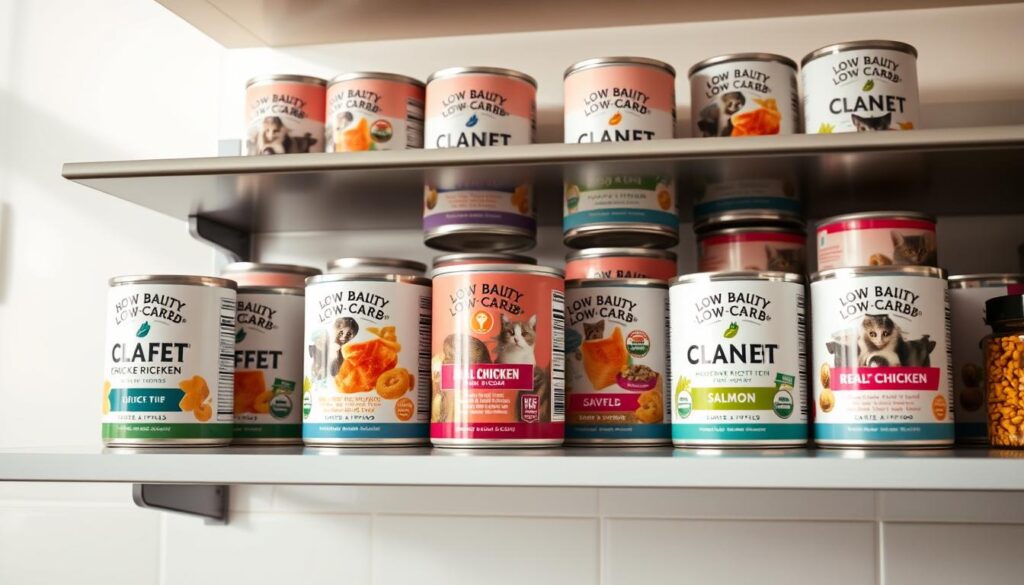
- Weight management
- Improved blood sugar control
- Reduced risk of certain health issues
A high protein, low carb canned cat food diet helps with weight, blood sugar, and health risks. It’s key to pick a high-quality low carb canned cat food that fits your cat’s needs.
The Benefits of High Protein, Low Carb Wet Cat Food
Cats need a diet full of animal protein and few carbs. A high protein, low carb diet helps with weight, blood sugar, and hydration. Low carb wet cat food fancy feast and best low carb canned cat food are great choices.
This diet keeps your cat at a healthy weight, lowering obesity risks. It also helps control blood sugar, which lowers diabetes risks. Wet cat food, like low carb wet cat food fancy feast, is full of water, which is key for staying hydrated.
Some key benefits of a high protein, low carb diet for cats include:
- Weight management
- Improved blood sugar control
- Increased hydration
- Reduced risk of obesity and related health issues
- Improved overall health and well-being
When picking low carb cat food, look for high protein and low carbs. Best low carb canned cat food has animal proteins and few carbs. Always talk to your vet to find the best diet for your cat.
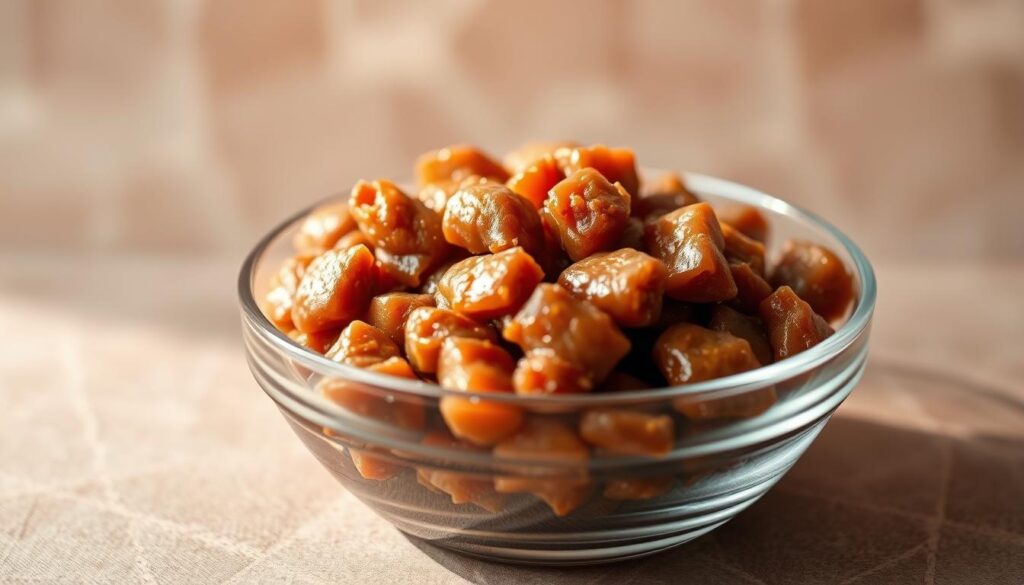
Feeding your cat a high protein, low carb diet ensures they live a happy, healthy life. With the benefits of low carb wet cat food fancy feast and best low carb canned cat food, now is a great time to switch to a low carb diet for your cat.
Top Low Carb Canned Cat Food Brands in the Market
Choosing the best low carb canned cat food is important. Many pet owners pick high protein low carb canned cat food for their cats. Brands like tuft + paw, Tiki Cat, and RAWZ offer a variety of options.
When picking a low carb cat food, look at the macronutrient balance. A good low carb cat food has lots of protein, some fat, and little carbs. For example, Tiki Cat After Dark Chicken & Quail Canned Cat Food has 66.6% crude protein. This makes it great for cats needing high protein.
Here are some top low carb canned cat food brands to consider:
- tuft + paw Really Great Cat Food: 12.4% carbohydrates on a dry matter basis
- Tiki Cat After Dark Chicken & Quail Canned Cat Food: 66.6% crude protein on a dry matter basis
- RAWZ Salmon Paté: 2.3% carbohydrates on a dry matter basis
- Nulo Freestyle Beef & Lamb Grain-Free Canned Cat Food: 34 calories per ounce
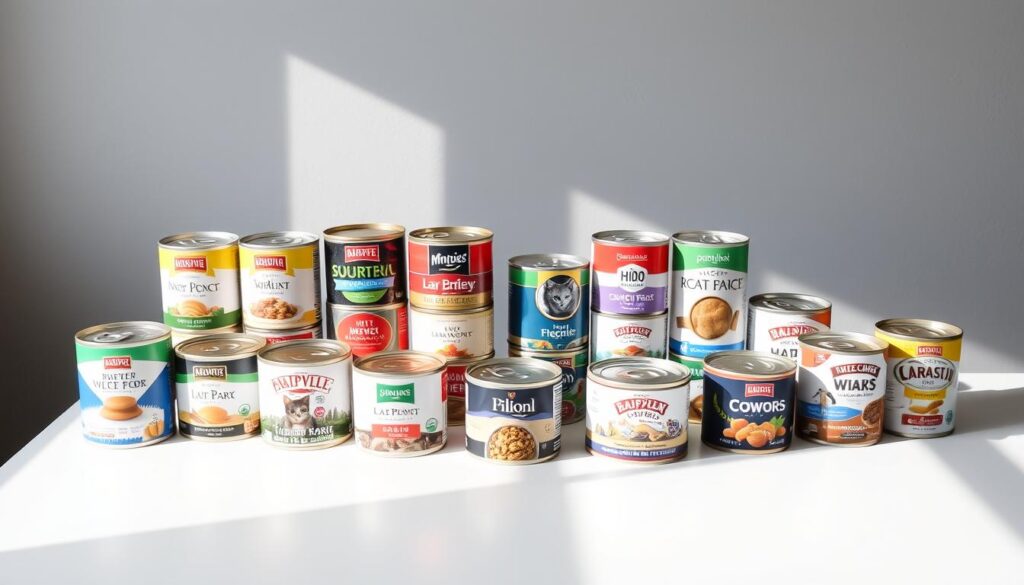
These brands offer a variety of options for different budgets and preferences. Choosing high protein low carb canned cat food helps ensure cats get the nutrients they need for health and happiness.
| Brand | Carbohydrate Content | Protein Content | Price per Ounce |
|---|---|---|---|
| tuft + paw | 12.4% | 9.8% | $0.52 |
| Tiki Cat | varies | 12% | $0.63 |
| RAWZ | 2.3% | 11% | $0.53 |
| Nulo Freestyle | varies | 12% | $0.42 |
Reading Cat Food Labels: What to Look For
Choosing a low-carb canned cat food means reading the label closely. A list of low carb dry cat food can guide your choices. Ingredients are listed by weight, with the heaviest first. For instance, regular chicken is mostly water, which changes its place on the list.
Understanding label terms is key. “Organic” means at least 95% organic ingredients. “Made With Organic Ingredients” means at least 70% are organic. Cat foods also have labels for different life stages, like “All Life Stages” for kittens and lactating cats.
Here are important things to check on a cat food label:
- Guaranteed analysis of at least four nutrients: minimum crude protein and crude fat, and maximum crude fiber and moisture
- Nutritional adequacy statements indicating if the food is suitable for specific life stages
- AAFCO defined feeding trials, which are considered the gold standard for pet food nutritional adequacy
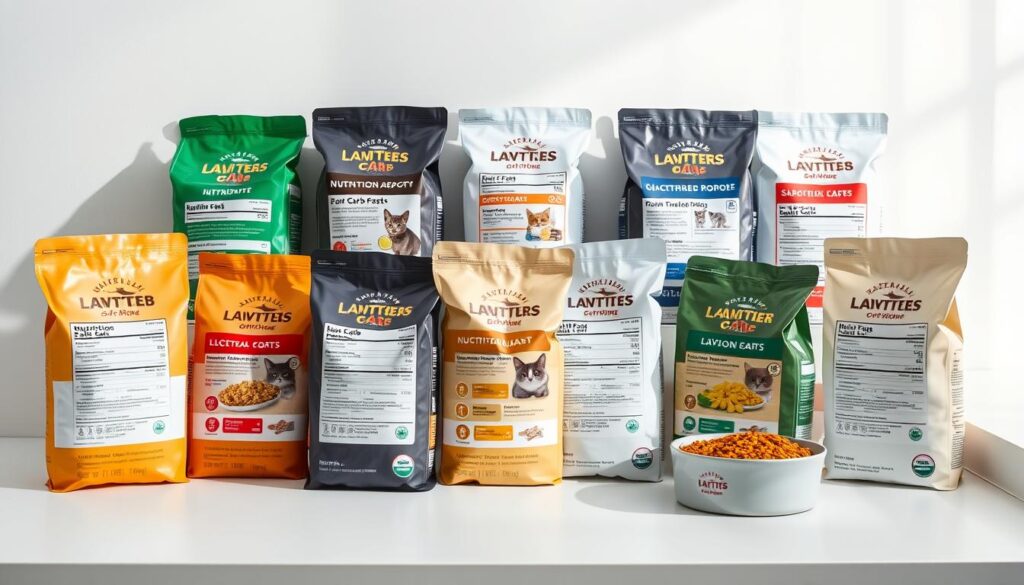
Knowing what to look for on a cat food label helps you choose wisely. A low carb dry cat food list can help compare options. This way, you can pick the best food for your cat’s needs.
Managing Diabetic Cats with Low Carb Wet Food
Diabetes mellitus is a common disease in cats, leading to many health problems. A key part of treating diabetes is a balanced diet. Low carb wet cat food for diabetic cats is a great choice. It helps keep blood sugar levels in check and manages the disease.
When picking a low-carb wet food, look for one with carbs under 10% of total calories. This is key for a diabetic cat’s diet.
A diabetic cat’s diet should have carbs under 10% of total calories. It’s best if carbs make up even less. About 50% or more of their calories should come from animal-based protein.
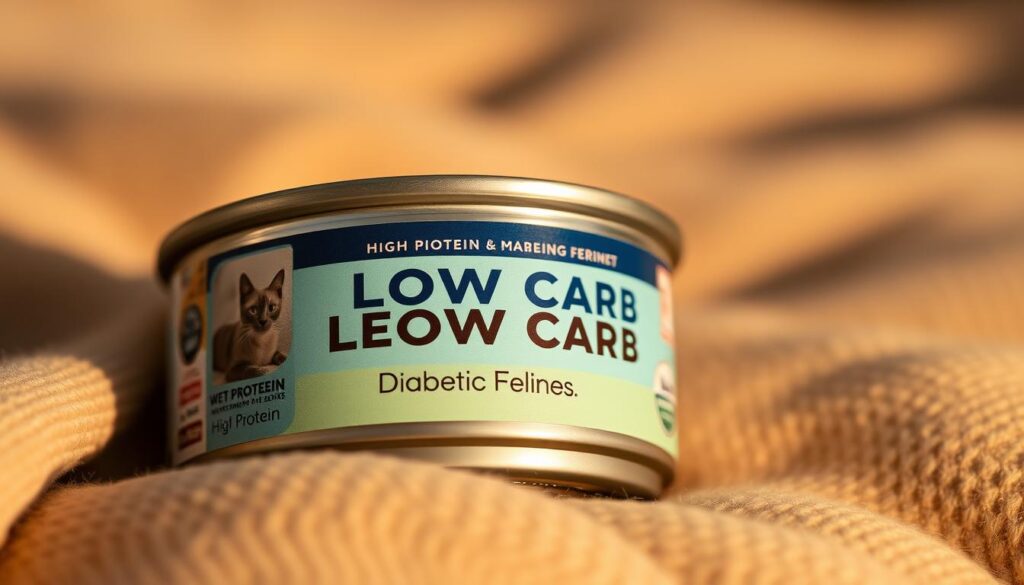
Some good low-carb wet cat food options for diabetic cats include:
- 9Lives: Pate varieties only
- Fancy Feast: Stick with chunky, classic, flaked, and roasted varieties; avoid gravy lovers and other high-carb options.
- Wellness: Complete Health line is low in carbs, but many other varieties may be too high.
Choosing high protein low carb wet cat food for diabetic cats can also help. In one study, 68% of cats with diabetes mellitus fed a low-carb diet no longer needed insulin. A low-carb diet can help your diabetic cat manage their condition and improve their health.
Transitioning Your Cat to Low Carb Canned Food
Switching your cat to low carb canned food should be done slowly. This helps prevent stomach problems. It’s best to take 1 to 2 weeks to make the change.
Here’s a good plan for feeding changes:
- Days 1-2: 75% old food and 25% new food
- Days 3-4: 50% old food and 50% new food
- Days 5-6: 25% old food and 75% new food
- Day 7: 100% new food
Keep an eye on how your cat reacts to the new food. If they don’t like it, go back to what they could eat before. Food low in carbs and high in protein is good for their health.
Always talk to your vet if you’re worried about changing your cat’s diet.
Common Myths About Low Carb Cat Food
Many pet owners think low carb cat food is too pricey. But, there are many affordable choices. Some top brands offer quality food without breaking the bank.
Some believe cats won’t like low carb food. Yet, many cats do well on it and their owners see big improvements. There are even different flavors to please every cat.
Low carb cat food helps with weight, blood sugar, and staying hydrated. It also lowers the risk of diabetes. This makes it a popular choice for many pet owners.
When picking low carb cat food, look for brands with good protein and few carbs. Foods like chicken or salmon are great. They’re full of protein and low in carbs. Choosing the right food can make your cat’s life better and happier.
Special Considerations for Senior Cats
As cats get older, their diet needs change. Senior cats, over 10 years old, need special care in their nutrition. Low carb wet cat food fancy feast is a good choice for them. It offers the moisture and nutrients they need for health.
Senior cats face health issues like muscle loss and chronic diseases. High protein low carb canned cat food helps by giving essential amino acids and less carbs. The National Research Council says senior cats need at least 12.5 grams of crude protein per 250 calories.
Important things to think about for senior cat diets include:
- Higher moisture content to help with hydration
- More protein to support muscle health
- Less carbs to manage blood sugar
- Supplements like glucosamine and chondroitin for joints
When picking a diet for your senior cat, look at this table:
| Diet Type | Moisture Content | Protein Content | Carbohydrate Content |
|---|---|---|---|
| Low carb wet cat food fancy feast | High | High | Low |
| High protein low carb canned cat food | Medium | Very High | Low |
Choosing the right diet can help your senior cat live a long, healthy life. Talk to your vet to find the best diet for your cat’s needs.
Comparing Low Carb Wet vs. Dry Cat Food
Choosing the right food for your cat is key. Look at the differences between low carb wet and dry cat food. Canned cat food has more moisture than dry food. This can help keep your cat hydrated and prevent health issues.
A low carb dry cat food list is a good start. But don’t forget about high protein low carb canned cat food. Canned food has about 70% water, while dry food has about 10%. This big difference affects your cat’s health.
High protein low carb canned cat food has many benefits. It:
- Helps with hydration and reduces urinary tract issues
- Is good for cats with diabetes or obesity
- Supports muscle health and overall well-being
On the other hand, low carb dry cat food is convenient and affordable. It lasts longer. But, think about what’s best for your cat. Choosing high protein low carb canned cat food can help your cat thrive.
Signs Your Cat is Thriving on Low Carb Food
When your cat eats low carb canned cat food, you’ll see big health improvements. Their coat will look shiny and healthy. They’ll also have more energy, thanks to the stable energy from low carb foods.
Low carb foods are high in protein, which is key for cats. They help grow and keep muscles strong. Cats also digest better, with less diarrhea and constipation.
Here are some signs your cat is doing well on low carb food:
- Improved coat condition and shine
- Increased energy levels and playfulness
- Better digestion and reduced symptoms of diarrhea and constipation
- Healthy weight management and reduced risk of obesity
Keep an eye on your cat’s health and change their diet if needed. Choosing high protein, low carb canned cat food supports their health.
Avoiding Common Mistakes When Feeding Low Carb
Feeding your cat a low-carb diet requires careful attention. Avoiding common mistakes is key to their health. Overfeeding or underfeeding can cause weight issues. Low carb wet cat food for diabetic cats is a good choice, but watch your cat’s health closely.
It’s also important to keep an eye on your cat’s health. This includes their blood sugar and weight. Regular vet visits can spot problems early. Choosing the right low carb canned cat food brands is also vital for your cat’s health.
- Make sure their diet is balanced and full of nutrients.
- Stay away from harmful fillers and artificial additives.
- Watch your cat’s health and adjust their food as needed.
By following these tips and picking the right low-carb cat food, your cat can stay healthy and thrive.
Conclusion: Making the Right Choice for Your Feline Friend
Choosing the right low-carb canned cat food is key for your cat’s health. Opt for a high-protein, low-carb wet cat food that meets their needs. This ensures they get the best nutrition for their vitality.
Proper diet and staying hydrated are vital. They help keep your cat at a healthy weight and blood sugar levels in check. This also prevents expensive vet bills later on.
Talk to your vet to find the best low-carb canned cat food for your cat. With their advice and the info in this article, you can choose wisely. This will give your cat the nourishment they need for a happy, healthy life.
FAQ
What defines low-carb cat food?
Low-carb cat food has less carbs than regular cat food. Cats naturally eat a lot of protein and fat, but not many carbs.
Why is a low-carb diet important for cats?
A low-carb diet helps cats in many ways. It helps with weight, blood sugar, and health issues. Cats do best on a diet rich in protein and low in carbs.
What are the benefits of high-protein, low-carb wet cat food?
High-protein, low-carb wet food is good for weight, blood sugar, and hydration. It keeps your cat healthy and at a good weight.
What are the top low-carb canned cat food brands?
Many top brands offer low-carb canned cat food. You can find premium, budget-friendly, and vet-recommended options. They meet different needs and budgets.
What should I look for when reading low-carb cat food labels?
When choosing low-carb canned cat food, check the labels. Look for high-quality protein, low carbs, and the right moisture. This ensures your cat gets what it needs.
How can low-carb wet food benefit diabetic cats?
Low-carb wet food is great for diabetic cats. Work with your vet to find the right feeding schedule. Also, watch your cat’s blood sugar when switching to low-carb.
How do I transition my cat to a low-carb canned food?
Gradually introduce your cat to low-carb canned food. Start with small amounts and watch for reactions. Adjust as needed for a smooth change.
What are common myths about low-carb cat food?
Some myths say low-carb cat food is expensive and cats don’t like it. But, there are affordable options and many cats like the taste of high-protein, low-carb food.
How does low-carb wet food compare to low-carb dry food?
Low-carb wet food has more moisture and better nutrition than dry food. The extra moisture helps keep your cat hydrated and healthy.
What are the signs that my cat is thriving on a low-carb diet?
If your cat is doing well on a low-carb diet, you’ll see better coat, energy, and digestion. These signs mean the diet is working for your cat.
What are common mistakes to avoid when feeding low-carb cat food?
Avoid overfeeding, underfeeding, and not watching your cat’s health. Follow good feeding practices and check with your vet often to meet your cat’s needs.
Also Read:


